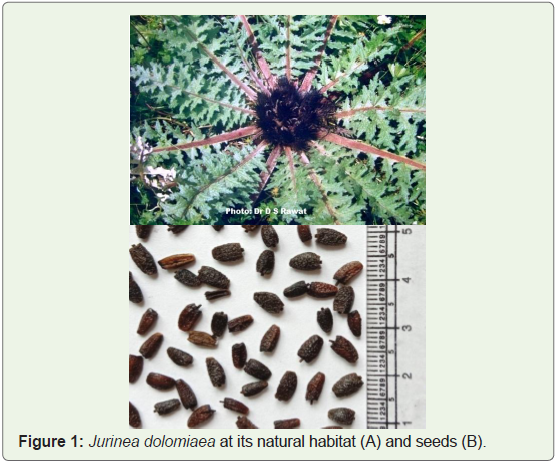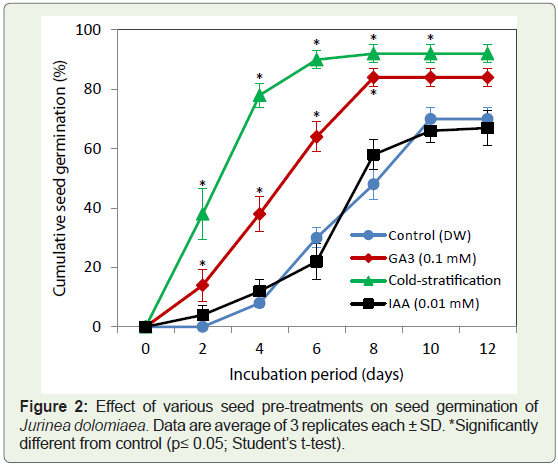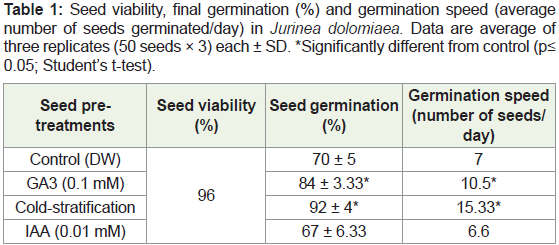Research Article
Assessment of Viability, Germination and Efficacy of Pre-treatments in Seeds of Jurinea dolomiaea, a Critically Endangered Medicinal and Aromatic Herb of Alpine Himalaya, from the Perspective of Conservation
Rajender Kumar Sharma1*, Anju K. Chhibber1, Vidisha Saxena2, Mukesh Kandpal2, Manpuran Swami2 and Sumit Sagar2
1Department of Botany, Deshbandhu College, University of Delhi, India
2Botany (Hons), III year (2020), Deshbandhu College, University of Delhi, India
*Corresponding author: Rajender Kumar Sharma, Department of Botany, Deshbandhu College, University of Delhi,
India Email: rksharmabio@yahoo.co.in Tel.: +91 011 26439565/ +91 9958598104 Fax: +91 011 26449396
Copyright: © Sharma RK, et al. 2023. This is an open access article distributed under the Creative Commons Attribution License,
which permits unrestricted use, distribution, and reproduction in any medium, provided the original work is properly cited.
Article Information: Submission: 13/10/2022; Accepted: 12/01/2023; Published: 16/01/2023
Abstract
Jurinea dolomiaea Boiss. (Asteraceae) commonly known as dhoop, found in high alpine Himalayas are rich in aromatic resin therefore, used as incense
locally as well as in dhoop industry. The species also valued for its medicinal importance to cure colic, puerperal fever, gout, rheumatism, poultice to eruptions,
and as stimulant. Further, its antibacterial, antimicrobial, antioxidative and anticancerous properties also have been reported. Currently, Jurinea dolomiaea has
an endangered population status due to unsystematic collection and overexploitation. Therefore, seed germination features were investigated. The seed
showed 96% viability and were non-dormant; 70% germination occurred within 10 days in control. Seed pre-treatments (GA3, 0.1 mM and cold-stratification)
enhanced the germination further and their role in germination improvement especially in alpine species is well known. Surprisingly, we did not find any
previous report on seed germination behavior of Jurinea dolomiaea and reporting it first time. The findings clearly indicated the suitability of seeds for propagation
and conservation of Jurinea dolomiaea, an endangered medicinal and aromatic herb.
Keywords
Conservation; Endangered; Jurinea dolomiaea; Medicinal-Aromatic Herb; Seed Germination
Introduction
Jurinea dolomiaea Boiss. (Asteraceae) commonly known as
dhoop or jari-dhoop or gugul-dhoop, distributed commonly on open
gently undulating alpine pastures, dry slopes and glacial moraines of
high alpine Himalayas at an altitude range of 3400 to 4500 m asl [1].
The stout tuberous roots are rich in aromatic resin and are used for
incense in temples, local houses, religious ceremonies and also sold
commercially as a main ingredient of dhoop industry [2]. Besides the aromatic properties, the species has also been valued for its medicinal
importance. The roots are, used to cure colic, puerperal fever, as
poultice to eruptions and considered as stimulant [3,4]. The aromatic
oil obtained from the roots is beneficial in gout and rheumatism [2].
Further, its antibacterial, antimicrobial, strong antioxidative, DNA
protective and anticancerous properties are also reported [5-9]. The
presence of high levels of secondary plant metabolites in various parts
of the plant signifies its effectiveness [8].
According to conservation assessment and management plan
(CAMP) workshop reports, the species has been categorized as
critically endangered in Himachal Pradesh [10] and has endangered
status in Uttranchal and J&K [11]. Thus, included in IUCN red
data list and considered as an endangered species. The latter is
owing to the overexploitation, unsystematic collection and trade of
wild population to meet the demand [12]. Therefore, propagation/
multiplication and/or conservation of the species are of urgent need
to restore the lost population.Jurinea dolomiaea can be propagated through
rhizome cuttings [13] and seeds. Surprisingly, we did not find any
report on seed germination behavior of Jurinea dolomiaea, thus the current
study was undertaken. The findings will be undoubtedly helpful for
the seed-based propagation and conservation of Jurinea dolomiaea, an
endangered medicinal and aromatic herb.
Material and Methods
Seed Collection:
The seeds of Jurinea dolomiaea were collected from the alpine slopes
near Tung Nath temple, Chopta, Uttarakhand, India at an altitude of
3800 m asl, during a Botanical excursion (September, 2019), organized
by the Botanical society of Deshbandhu College, University of Delhi.
The seeds were dried in shade for ten days and then stored in airtight
container at room temperature for further study.Viability Test:
Seed viability was assessed through tetrazolium reduction test as
followed by Sharma et al. [14]. Where, the seeds were first surface
sterilized with absolute alcohol for about 30 seconds, followed by
through washing with distilled water (DW) and kept submerged in
100 ml of DW for 24h at 25 ºC. After 24h the seed coat was removed
manually and the embryos were incubated with 0.3% aqueous
solution of 2,3,5-triphenyl tetrazolium chloride (TTC) for 24h at
25 ºC under complete darkness. The embryos which turned complete
pink were considered as viable.Seed Germination Assays:
Seeds with uniform size and shape were selected and surface
sterilized with absolute alcohol for 30 seconds, washed, and soaked in
distilled water for 24h at 25 ºC. Thereafter, the seeds were transferred
to Petri plates lined with moist substratum (3-4 layers of filter papers,
hydrated with DW) for germination in BOD incubator at 25 ºC. The
emergence of 3-5 mm radicle was considered as seed germination.Seed Pre-treatments:
To stimulate or enhance the seed germination, seeds were pretreated
with gibberellic acid (GA3, 0.1 mM), Indole acetic acid (IAA,
0.01 mM) and moist cold-stratification (5 ºC), respectively. In brief,
surface sterilized seeds were socked in stated concentrations of
GA3 and IAA for 24h at 25 ºC and were shifted to Petri plates for
germination. For moist cold-stratification, 24h socked seeds (DW)
were placed on moist substratum in Petri plates and kept at low
temperature (5 ºC) in refrigerator for 15 days. Thereafter the Petri
plates were transferred in to BOD incubator at 25 ºC for germination.
In all the cases the moisture level of substratum was maintained by
addition of DW.Germination Speed:
Final germination percentage/ Day of completion of germinationData Analysis:
All the experiments were carried out in triplicates. The data were
expressed as mean percentage value ± SD. The statistical differences
between means were calculated based on the Student’s t-test.Results and Discussion
Jurinea dolomiaea is an important species of high altitude
Himalaya, and considered as the prime indicator of the alpine region
[15]. It is a perennial prostate herb with rosette form, leaves arising
at the base, deeply pinnatifid and white tomentose beneath. Flowers
in dense deep purple heads, short stalked arising at the center of the
leaf rosette (Figure 1A). Seeds are brownish, little curved (Figure 1B) with brown pappus. The plant is extensively utilized for its high
medicinal and aromatic properties and become endangered due
to overexploitation [16]. Therefore, seed based multiplication or
conservation possibilities have been investigated. The plant produces
a reasonably good number of healthy and viable seeds per capitulum
and the number of capitulum/plant vary depending upon the age of
plant. However, we did not count the number of seeds/plant here.
The average length and width of seed measured was 5.3 and 3.2 mm,
respectively and weight was 23.8 mg (Average of 50 hydrated seeds).
In the present study, seed of Jurinea dolomiaea from Uttrakhand
Himalaya, showed 96% viability as observed through TTC-reduction
assay. The seeds were non dormant and exhibited convincingly good
germination in control itself. Seeds germination started on 3rd day of
incubation and finally reached to 70% germination within 10 days.
GA3 application significantly enhanced the germination. Due to
GA3 (0.1 mM) pre-treatment 84% germination was recorded against
70% in control (Figure 2). GA3 not only enhanced the germination
percentage but also increased the germination speed or reduced
the time required of germination significantly (Table 1). The role of
Gibberellins in breaking seed dormancy and enhancing germination
rate is well known. GA stimulate germination processes by stimulating the activities of hydrolytic enzymes [17,18], enzymatic loosening of
seed coat [19], fulfill the requirement of after-ripening, and coldstratification
[20]. The application of IAA seed pre-treatment did not
affect the germination significantly. Moist cold-stratification of seeds
at 5 ºC for 15 days significantly increased the germination speed as
well as the final germination percentage (Figure 2, Table 1). Thus, 92%
germination was achieved with in a week. The effectiveness of coldstratification
in breaking seed dormancy or germination improvement
in alpine species is well reported [19,21]. Cold-stratification actually
simulates the natural conditions essentially experienced by the seeds
of alpine region after dispersal. Where, seeds remain under snow
or exposed to low temperature during winter months before the
initiation of germination. In addition, cold-stratification effectively
breaks various forms of seed dormancy (physiological, morphological
and morpho-physiological), increase embryo growth potential and
sensitivity of seed tissue towards GA, fulfills the requirement of GA
and/or after-ripening [21,22]. Therefore, cold-stratification has been
generally utilized to achieve uniform seed germination.
Figure 2: Effect of various seed pre-treatments on seed germination of
Jurinea dolomiaea. Data are average of 3 replicates each ± SD. *Significantly
different from control (p≤ 0.05; Student’s t-test).
Table 1: Seed viability, final germination (%) and germination speed (average
number of seeds germinated/day) in Jurinea dolomiaea. Data are average of
three replicates (50 seeds × 3) each ± SD. *Significantly different from control (p≤
0.05; Student’s t-test).
Banday et al. [13] reported about the possibility of vegetative
propagation of Jurinea dolomiaea through rhizome cuttings and find out
the efficacy of certain plant growth regulators to improve the same.
However, seed based propagation is considered comparatively easy,
practical, cost effective, natural and reported to have many advantages
over vegetative propagation [23]. The current observations on seed
viability and germination of Jurinea dolomiaea here also support the above points. Surprisingly, in spite of high demand, economic importance
and endangered status of the species, there is complete lack of
information about the seed viability and germination aspects of Jurinea dolomiaea and we are reporting here first time.
Conclusion
The present findings on seed germination of Jurinea dolomiaea clearly
indicated the suitability of seeds for propagation and conservation of
the species. Since, most alpine perennial plants including Jurinea dolomiaea
exhibit very sluggish growth, the cultivation cannot be commercially/
economically viable. Therefore, in-situ conservation with periodic
systematic extraction through skilled workers can be recommended.
Further, conservation of species in its natural habitat has ecological
significance and ensures local livelihoods, quality of raw drug
availability and trade. The realization of the same requires a sincere,
realistic and practical approach.
Acknowledgements
The financial support by Department of Biotechnology,
Government of India under DBT-Star-College scheme is thankfully
acknowledged. We are also thankful to Dr. D.S. Rawat, G.B. Pant
University of Agriculture & Technology Pantnagar, for permitting us
to use the picture.



